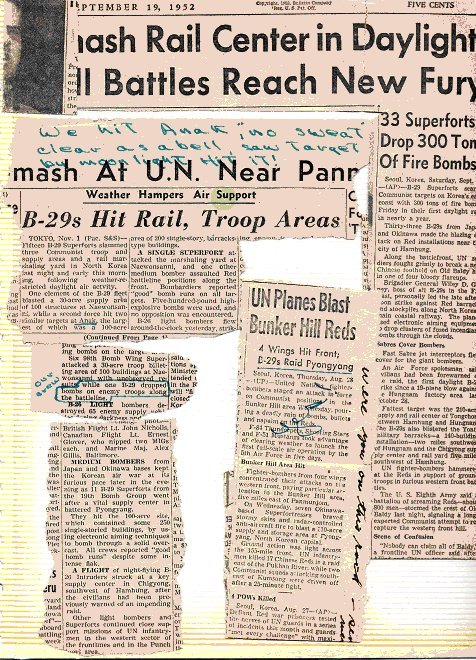PRIMER MISSIONS - (Front Line Support)
Bud Farrell
Any missions for which only one or two crews from our squadron were "up" on the mission board were usually a "Milk Run" Primer Mission, front line support along the 38th Parallel and always a welcome relief since they all counted as a mission! We did not have a set number of missions required for rotation home, as had generally been the case in World War II, but rather just a six month combat tour that could represent a greater or lesser number of missions than an average 25 , just the luck of the draw. So , although a "Primer Mission " didn't chalk off a critical number, it DID take up a day and night that might have sent us farther north into more hostile circumstances than we would usually experience along the front lines. The frequency of Primer Missions by all B-29 Bomb Groups varied with the "push" by the Chinese and/or North Korean Forces, with some of the targets becoming historic names such as "Bunker Hill", "Heartbreak Ridge", and "Pork Chop Hill."
All of the required preflight inspection was virtually the same as for any mission simply because we did not know until briefing later in the day just what type of target we were going to that night. The type of bomb loading under way was somewhat of a tip-off, in that if there were 100 pounders being loaded it was usually going to be an airfield, always a difficult and well defended target, and of course the accompanying apprehension then through the whole day until briefing. Loading of 500 pounders revealed nothing since these were used on the majority of industrial targets, bridges, Chinese Army Headquarters, railroad marshalling yards, supply depots , AND troop concentrations along the front lines. The LACK of loading of any photoflash bombs, and a FULL load of HE (high Explosive) iron bombs usually indicated front line support, but full bomb loading wasn't always complete by briefing time.
Photoflash bombs were set to go off in the air, one prior to impact of the HE bombs, one to flash during detonation of the bomb load on target, the last to record the impact and smoke in the target area after impact. The photoflash bombs were regarded as somewhat more dangerous to carry than the HE bombs since these were armed and set off by a certain number of rotations of the small propeller at the head of the fuse, NOT on impact as was usually the case with HE bombs. There were occasions when we DID have HE bombs armed with VT (Variable Time) fuses set to explode just above the ground for flak and searchlight suppression of antiaircraft gun crews and equipment. We also used delayed timing fuses for psychological affect on repair crews.
Although time TO the target area was substantially less than to the far northern Yalu industrial targets, time OVER the target in front line support made total mission duration just about the same, a typical 9 to 9 1/2 hours. Upon arrival in the front line area we would be in radio contact with a front line ground controller who would identify our individual aircraft on radar by issuing a variety of directional change orders, following our turns on his screen to assure that we were "his ship." After appropriate confirmations, he would then vector- direct or guide - us on a specific heading and tell us what altitude, heading, number of bombs to drop (usually 10 of our 40 - 500 pounders) and the intervalometer setting we should use for spacing of the bombs. We would make at least 4 runs through an hour to an hour and a half over the lines, with a great deal of jockeying and ground controller identification maneuvering between runs.
The great amount of time spent just across and along the lines was not nearly as hazardous to us as missions north of the lines deep within enemy territory. All of the searchlights, with incredible artillery duels of heavy guns and spectacular barrages of rockets, were aiming from hill to hill at ground level, and precluded their use against us by the enemy, thus we were on a grand tour of a light show beyond that of ANY July 4 th ! Any "triple A" from the ground seeking the lower flying B-26's or other low level fighter bombers, was usually 20MM, 37MM, or 40MM, and effective only up to about 10 to 12 thousand feet, well below us. The strings of rounds, so frequently described as "golf balls", appeared to be in slow motion from a distance ... and were quite colorful and pretty to watch ... from a great DISTANCE! The memorable live scenes on TV at the opening of the Gulf War, and the AAA fire over Baghdad, astonished my family and perhaps for the very first time stimulated questions of whether I had "ever seen that?"
Our ballet above the lines did not reflect the probable horrors being experienced on the ground ... with troops of both sides either out on night patrols, or U.N. allied troops retreating within themselves and within earthen bunkers, my cousin Vic among them, fending off attacks by Chinese hordes that were massed for the attacks that we were attempting to break up from the air. As a gunner, with little to fear from AAA , searchlights, or fighter attacks this far south, and with no major reports to give on interphone to interrupt the cockpit concentration on ground controller directions, I had a lot of time to watch the show below ... and to thank God that I had not gone into the Army or Marine Infantry like cousins Bob Palmer or Vic Dunn ... facing "the enemy below"!!
 |